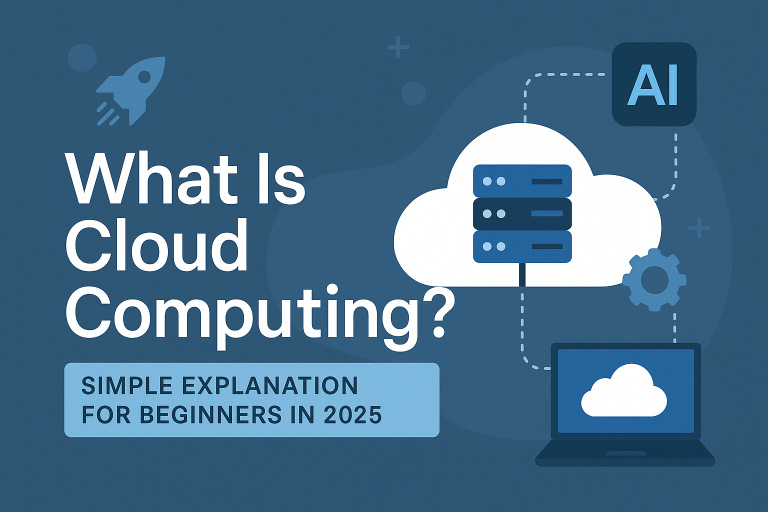What Is Cloud Computing? A Powerful 3-Part Guide to Elasticity
What is cloud computing?
It’s a revolutionary way businesses manage technology — and it’s opening massive career opportunities.
Before cloud computing, growing a business meant risking everything on expensive, unpredictable hardware. Companies had to guess their future demand, invest huge amounts up front, and hope for the best.
It was stressful, costly, and full of uncertainty.
Today, thanks to cloud computing, that stress is largely gone.
Companies can now scale instantly based on real-time demand — and only pay for what they actually use.
This shift levels the playing field for startups, career changers, and small businesses.
At the heart of this revolution are two powerful concepts:
Elasticity and Economies of Scale.
Let’s dive into what cloud computing really means today — and why mastering these fundamentals could be your first step to launching a thriving tech career.
➔ Want a full roadmap to start your cloud career? Download my free Starter Guide here.
Table of Contents
➔ Explore more about launching your cloud career on The Cam Miller Blog.

Understanding Cloud Computing: Elasticity, Scalability, and Cost Advantages
When beginners ask, “what is cloud computing?”, the simplest answer is:
It’s on-demand access to computing power, storage, and services — without needing your own physical servers.
Elasticity in Cloud Computing
Elasticity means your cloud services automatically scale based on real-time demand — without you needing to manually adjust anything.
Cloud computing, at its core, is the on-demand delivery of computing services — from servers to databases to software — over the internet (“the cloud”).
Instead of owning and maintaining expensive physical servers and other networking hardware, you rent them from providers like:
This pay-as-you-go model gives businesses unmatched flexibility, cost control, and scalability.
Simply put:
Cloud computing lets you grow your skills — or your business — without getting bogged down managing hardware.
How Elasticity Powers Cloud Computing Scalability
Elasticity is a core feature of cloud computing. It lets your resources automatically scale up or down — either vertically (adding more power to existing servers) or horizontally (adding more servers to handle increased load) — based on real-time demand, without manual work.
Example:
- Your app suddenly gets 10x more traffic?
➔ More servers automatically spin up. - Traffic drops again?
➔ Servers scale back down.
Elasticity ensures:
- You never overpay for unused capacity.
- You never crash from unexpected demand.
- Your apps stay fast, reliable, and cost-effective.
Every major provider — GCP, AWS, and Azure — builds elasticity into their platforms to make scaling effortless.
Elasticity is one of the defining features that makes cloud computing so powerful for businesses today.
How Economies of Scale Make Cloud Computing Affordable
Economies of scale are another reason cloud computing has become so affordable for businesses of every size.
Together, scalability and economies of scale fundamentally change how businesses invest in technology.
How Scalability and Economies of Scale Lower Costs
Instead of every company buying their own servers:
- Millions share powerful global data centers.
- Costs get distributed across users.
- Everyone benefits from lower prices, better hardware, and world-class security.
Key Benefits of Cloud Economies of Scale:
- Lower monthly costs
- Faster infrastructure upgrades
- Higher availability and performance
Cloud computing makes it possible for even small startups to operate with enterprise-level power — at a fraction of traditional costs.
Thanks to economies of scale, what cloud computing offers is not just flexibility — but also major cost savings for businesses of every size.
Before and After Cloud Computing: How Businesses Have Transformed
| Pre-Cloud Era | Cloud Era Today |
|---|---|
| Spend $10K–$100K on servers upfront | Pay monthly for usage |
| Overbuy or underbuy server capacity | Scale automatically in real-time |
| Long delays for hardware setup | Launch apps in hours |
| Massive maintenance and risk | Cloud providers handle maintenance |
The result?
Innovation happens faster. Risks drop. Costs shrink.
GCP vs AWS vs Azure: Which Cloud Platform Excels at Elasticity and Scale?
- AWS
➔ Offers the largest service catalog and leads the market in size and scale. Ideal for businesses that need rapid, global scaling across multiple regions. - GCP
➔ Known for cost-effectiveness, sustained usage discounts, and industry-leading data, analytics, and AI tools. A strong choice for data-driven startups and AI innovators. - Azure
➔ Best for businesses already using Microsoft products like Office 365, Dynamics, or Windows Servers. Seamlessly integrates cloud services with existing Microsoft ecosystems.
Bottom Line:
All three platforms leverage elasticity and economies of scale.
The best choice depends on your business goals, technical needs, and existing technology stack. Choosing the right cloud provider is less about picking a winner — and more about aligning features to your specific goals.
Why Understanding Cloud Computing Fundamentals Will Launch Your Career Faster
Mastering cloud fundamentals like elasticity and economies of scale isn’t just nice to know —
It’s critical for real-world success in today’s tech-driven business ecosystem.
Employers and clients aren’t looking for people who can simply list cloud services.
They’re hiring professionals who can explain — with clarity — how the cloud saves money, accelerates innovation, and helps businesses scale smarter.
If you can confidently break down concepts like elasticity, scalability, and cloud cost advantages,
you won’t just compete — you’ll stand out in tech interviews, freelance projects, and consulting opportunities.
The future belongs to those who can turn cloud knowledge into real-world results.
Ready to Launch Your Cloud Career? (Free Starter Guide)
🚀Get Your Free Starter Guide!
Launch Your Cloud Career: A Simple Blueprint to Master Cloud, AI, and Python in Just 6 Months
✅Learn exactly:
- What skills to master
- Which certifications to target
- How to build real momentum — even if you’re starting from scratch
✅Inside the guide, you’ll discover:
- The #1 mistake beginners make (and how to avoid it)
- Core cloud, Python, and AI skills employers actually want
- A 90-day action plan to build your first real-world cloud skills
- Top free and affordable learning resources to fast-track your success
- How to stay motivated and build your dream tech career
👉 Download your free copy now and start building a future-proof career today!
What is cloud computing and why is it important today?
Cloud computing is the on-demand delivery of servers, storage, and services over the internet. It allows businesses to scale instantly, lower technology costs, and innovate faster than with traditional on-premise systems.
What does elasticity in the cloud mean for businesses?
Elasticity in cloud computing allows businesses to automatically scale computing resources up or down based on real-time demand, helping them stay cost-efficient while handling traffic spikes without downtime.
What are the top benefits of cloud computing for startups and small businesses?
The main benefits of cloud computing include lower upfront costs, on-demand scalability, access to world-class infrastructure, faster time-to-market, improved data security, and reduced operational risk.
What are cloud fundamentals beginners should understand first?
Core cloud fundamentals include understanding services like Compute, Storage, Networking, and Security. These basics help beginners grasp how cloud platforms work and prepare them for certifications and real-world projects.
How do economies of scale in the cloud reduce costs for companies?
Economies of scale in the cloud mean providers like AWS, GCP, and Azure serve millions of users, spreading infrastructure costs across customers. This lowers prices, improves technology access, and delivers enterprise-grade performance even for small businesses.
Mastering these cloud fundamentals lays the foundation for everything you’ll build — whether you’re launching a future-ready tech career or scaling a smarter business.
🚀 Want a Clear Plan to Start Your Cloud + AI Career?
Download the free Cloud Career Blueprint — a step-by-step guide to help you learn the right skills, avoid overwhelm, and start building a high-value career in tech.
👉 Just enter your email below and I’ll send it straight to your inbox.







